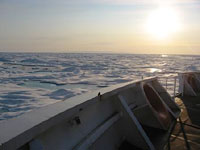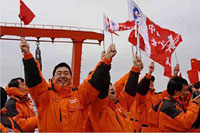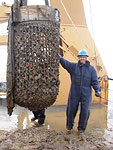

 | |||||||||||||||||
|
|
Journals 2008/2009Steve Howard
September 1, 2008 We woke up this morning to bright sunshine, which is a welcome sight after a string of cloudy weather and light snow flurries. The timing is good, since I plan on doing some video work today and this bright light will bring out the beauty in the landscape. The Canadian Broadcasting Channel asked us to film specific research activities and shots of the Healy and the Arctic scenery, and I've volunteered to take on some of this. If we give them "good tape," they plan on using it in a documentary they are producing of the seafloor mapping work going on in the Arctic. Should this all work out, it would be great to get a copy of the documentary and show it to my classes. I don't have really any experience doing video work beyond the basics, but my roommate David is a professional so I'm going to hit him up for advice.
We have turned away from our northern most extent, and are now heading back south across the Canada Basin and back toward the Chukchi Cap, and eventually on to Barrow. As we make our approach closer to home, my thoughts increasingly turn to returning back to Seattle, my family, and the start of another school year. An interesting event unfolded yesterday evening, as we came within sight of another vessel, the Chinese icebreaker Xuelong (or "snow dragon"), which is conducting scientific research on the biology, climate and geology of the Arctic Ocean. This is China's third scientific Arctic exploration, and although China has no claim to resources in the area under the Law of the Sea, its presence here is a reminder of the global importance of the region's rapidly altering ecosystem.
As we enter our final leg of the cruise, our mission focus is shifting to dredging and sampling of the rocks and sediments in strategic locations that we have mapped. When Kelley asked for help going through the dredge mud to pick out the rocks, I jumped at the chance (I've been eager to get my hands dirty this entire trip!). My job basically involves stomping through a mountain of sticky muck with my boots until I feel a hard rock beneath my foot, reaching into that ooze to find the rock, and then putting it in a bucket to be sorted back in the lab. Then, back to more stomping and sorting until the mud has been thoroughly worked over. It's about the stickiest mud I've ever felt, and a few times I thought I'd pull my foot out of my boot. Actually its kind of fun... I always loved playing in the mud as a kid!
Knowing what types of rocks are found in these areas is very important information. For a nation to satisfy the requirements of the Law of the Sea and expand its claim to sovereign rights to resources of the seafloor beyond the 200 nautical mile limit, it must be demonstrated that the there is a natural prolongation of the continental landmass. As we separate the rocks from the mud in these dredge samples, data is gathered to determine the type of rocks so that we can better understand the geologic history of the region and thus determine whether or not it will qualify for an extended continental shelf. |
||||||||||||||||



